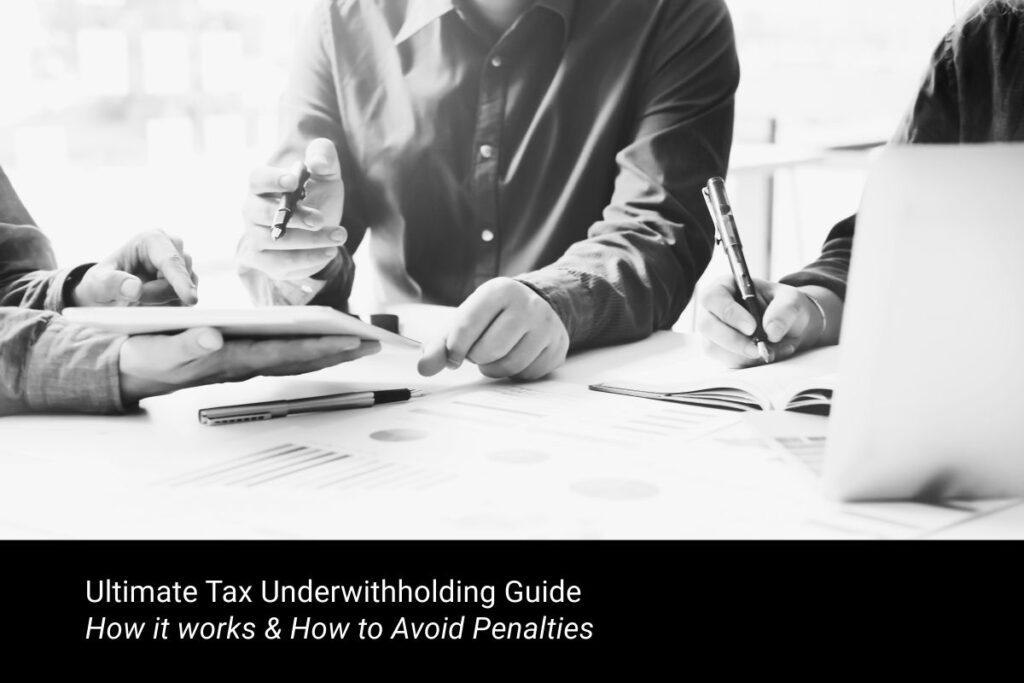When you’re filing your tax return and discover that you owe taxes, you may wonder if you’ll face penalties or interest, or if you’re in trouble with the IRS. As with most financial matters, the answer depends on various factors. In this guide, we’ll break down tax underwithholding and help you understand whether you should be concerned about it.
What is Tax Underwithholding?
Many taxpayers are familiar with the concept of receiving a tax refund, where you’ve overwithheld or overpaid your taxes throughout the year, and the IRS returns the excess money to you in the form of a refund. Tax underwithholding, on the other hand, is the opposite scenario. It occurs when individuals don’t withhold enough taxes from their income throughout the year, potentially resulting in owing taxes to the state or federal government.
Why You Should Care About Tax Underwithholding
You might be wondering, “If I can pay the IRS when tax time comes, why should I withhold more throughout the year?” This is a common question, but it’s essential to understand that the U.S. tax system operates on a “pay-as-you-earn” basis. The IRS expects taxpayers to pay their taxes as they earn income, often through quarterly tax payments or tax withholding from W-2 income. Failure to adhere to IRS underwithholding rules and not paying taxes on time can lead to underwithholding penalties. The IRS charges an interest rate of 8% on tax under payments as of Q4 2023. However, as you will learn you can still OWE a tax when you file and avoid underwitholding penalties, depending on how much tax payment you have made throughout the year.
How to Determine How Much to Withhold
Effective tax planning is about not overpaying the IRS. To determine how much to withhold throughout the year, you can use the IRS’s “Safe Harbor” numbers for estimated tax payments. The Safe Harbor numbers are the minimum amounts you should withhold or pay in estimated taxes to avoid underwithholding penalties. You can calculate your Safe Harbor number using one of the following methods:
- Withhold or pay in estimated taxes equal to 90% of the tax you owe for the current year.
- Withhold 100% of the tax you owed in the previous tax year.
- If your Adjusted Gross Income (AGI) on your prior year’s return is over $150,000 for a married couple ($75,000 for those filing separately), you can withhold or pay in estimated taxes equal to 90% of the current year’s tax liability or 110% of the tax shown on the previous year’s return.
Example:
Consider a couple with a joint return AGI of $100,000 in 2022. Their Federal Tax Liability is $10,000 (found on line 24 of their 1040). In 2023, their AGI increases to $135,000, making their Federal Tax Liability $16,000. To avoid underwithholding penalties, they need to withhold from their paychecks or pay quarterly estimated taxes, totaling either 90% of their current year tax liability ($14,400) or 100% of last year’s tax liability ($10,000). Different withholding scenarios include:
- If they withhold $12,000 from their jobs throughout the year and owe an additional $4,000 at tax time, they won’t incur penalties because they followed the Safe Harbor rules, withholding more than 100% of the prior year’s tax liability.
- If they withhold only $7,000 from their jobs and owe $9,000 at tax time, they will owe penalties since they withheld less than the Safe Harbor numbers.
High Income Example:
Imagine a couple filing a joint return with AGI of $250,000 in 2022. Their Federal Tax Liability is $43,000 (line 24 of their 1040). In 2023, their AGI increases to $300,000, making their Federal Tax Liability $54,000. To avoid underwithholding penalties, they need to withhold from their paychecks or pay quarterly estimated taxes, totaling either 90% of their current year tax liability ($48,600) or 110% of last year’s tax liability ($47,300), as their AGI exceeds $150,000.
How to Plan Around Tax Withholding:
For most individuals with W-2 income, determining how much to pay in taxes throughout the year involves checking how much is already being withheld from their paychecks. The IRS Tax Withholding calculator can help you assess your yearly withholdings. If you find you need to withhold more, you may need to complete a new W-4 form to request additional tax withholding per paycheck.
For self-employed individuals, such as single-member Sole Proprietor LLC, quarterly tax payments are typically required since they lack payroll. However, single-member LLCs filing as S-Corps have more flexibility. They can choose to withhold taxes from their salary and/or make quarterly tax payments. This flexibility exists because the IRS accepts both payroll withholding and quarterly tax payments as valid methods to prevent underwithholding.
Retired individuals relying on pre-qualified funds, such as IRAs, should ensure they withhold an appropriate amount from their IRA distributions to meet their safe harbor obligations. Withholding from an IRA distribution is an acceptable way in the eyes of the IRS to fulfill tax payments throughout the year and potentially avoid any underwithholding penalties.
How Much Should You Withhold?
Ideally, you should withhold the minimum amount required to stay compliant with your safe harbor number. This allows you to earn interest on the money you would owe the IRS come tax time and then pay the difference between your tax liability and withholding. However, not everyone has the discipline to set aside this money and not spend it. Some individuals prefer the peace of mind that comes with withholding more, even if they are already in compliance with the safe harbor amount.
Need a Tax Plan?
If you’re still feeling overwhelmed by tax planning and avoiding underwithholding penalties, consider getting a comprehensive tax plan which covers these issues. If you don’t have a comprehensive tax plan, you can schedule a complimentary discovery call to get started below.
Disclosure: This article is intended to be financial education only and is not intended to be specific tax, legal, or investment advice. Please consult a professional for specific advice.










